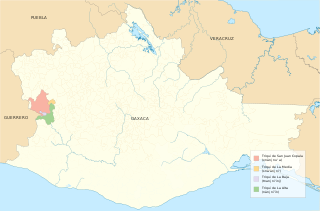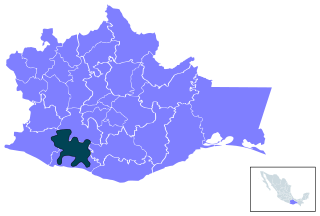
Whistled languages are linguistic systems that use whistling to emulate speech and facilitate communication between individuals. More than 80 languages have been found to practice various degrees of whistling, most of them in rugged topography or dense forests, where whistling expands the area of communication while movement to carry messages is challenging. The practice is generally threatened by increased modernization and faster roads, but successful conservation efforts are recorded.

The Oto-Manguean or Otomanguean languages are a large family comprising several subfamilies of indigenous languages of the Americas. All of the Oto-Manguean languages that are now spoken are indigenous to Mexico, but the Manguean branch of the family, which is now extinct, was spoken as far south as Nicaragua and Costa Rica. Oto-Manguean is widely viewed as a proven language family.

The Mazatecan languages are a group of closely related indigenous languages spoken by some 200,000 people in the area known as the Sierra Mazateca, which is in the northern part of the state of Oaxaca in southern Mexico, as well as in adjacent areas of the states of Puebla and Veracruz.

Amuzgo is an Oto-Manguean language spoken in the Costa Chica region of the Mexican states of Guerrero and Oaxaca by about 60,000 speakers. Like other Oto-Manguean languages, Amuzgo is a tonal language. From syntactical point of view Amuzgo can be considered as an active language. The name Amuzgo is claimed to be a Nahuatl exonym but its meaning is shrouded in controversy; multiple proposals have been made, including 'moss-in'.

The Zapotec languages are a group of around 50 closely related indigenous Mesoamerican languages that constitute a main branch of the Oto-Manguean language family and are spoken by the Zapotec people from the southwestern-central highlands of Mexico. A 2020 census reports nearly half a million speakers, with the majority inhabiting the state of Oaxaca. Zapotec-speaking communities are also found in the neighboring states of Puebla, Veracruz, and Guerrero. Labor migration has also brought a number of native Zapotec speakers to the United States, particularly in California and New Jersey. Most Zapotec-speaking communities are highly bilingual in Spanish.

Otomi is an Oto-Pamean language spoken by approximately 240,000 indigenous Otomi people in the central altiplano region of Mexico. Otomi consists of several closely related languages, many of which are not mutually intelligible. The word Hñähñu has been proposed as an endonym, but since it represents the usage of a single dialect, it has not gained wide currency. Linguists have classified the modern dialects into three dialect areas: the Northwestern dialects are spoken in Querétaro, Hidalgo and Guanajuato; the Southwestern dialects are spoken in the State of Mexico; and the Eastern dialects are spoken in the highlands of Veracruz, Puebla, and eastern Hidalgo and villages in Tlaxcala and Mexico states.
Ixcatec is a language spoken by the people of the Mexican village of Santa María Ixcatlan, in the northern part of the state of Oaxaca. The Ixcatec language belongs to the Popolocan branch of the Oto-Manguean language family. It is believed to have been the second language to branch off from the others within the Popolocan subgroup, though there is a small debate over the relation it has to them.

The Oto-Pamean languages are a branch of the Oto-Manguean languages that includes languages of the Otomi-Mazahua, Matlatzinca, and Pamean language groups all of which are spoken in central Mexico. Like all Oto-Manguean languages, the Oto-Pamean languages are tonal languages, though most have relatively simple tone systems. Unlike many Oto-Manguean languages that tend towards an isolating typology, they are morphologically complex headmarking languages with complex systems of conjugational classes both for verbs and nouns, and in the Pamean languages there are highly complex patterns of suppletion.

The Triqui, or Trique, languages are a family of Oto-Manguean spoken by 30,000 Trique people of the Mexican states of Oaxaca and the state of Baja California in 2007. They are also spoken by 5,000 immigrants to the United States. Triqui languages belong to the Mixtecan branch together with the Mixtec languages and Cuicatec.
Huave is a language isolate spoken by the indigenous Huave people on the Pacific coast of the Mexican state of Oaxaca. The language is spoken in four villages on the Isthmus of Tehuantepec, in the southeast of the state, by around 20,000 people.

Chatino is a group of indigenous Mesoamerican languages. These languages are a branch of the Zapotecan family within the Oto-Manguean language family. They are natively spoken by 45,000 Chatino people, whose communities are located in the southern portion of the Mexican state of Oaxaca.

The Mixtecan languages constitute a branch of the Oto-Manguean language family of Mexico. They include the Trique languages, spoken by about 24,500 people; Cuicatec, spoken by about 15,000 people; and the large expanse of Mixtec languages, spoken by about 511,000 people. The relationship between Trique, Cuicatec, and Mixtec, is an open question. Unpublished research by Terrence Kaufman in the 1980s supported grouping Cuicatec and Mixtec together.
Sochiapam is a Chinantec language of Mexico. It is most similar to Tlacoatzintepec Chinantec, with which it has 66% intelligibility.
Usila is a Chinantec language of Mexico. It is most similar to Tlacoatzintepec Chinantec, with which it has 50% intelligibility.
Zaniza Zapotec is an Oto-Manguean language of western Oaxaca, Mexico. It is one of several Zapotec languages called Papabuco. It has only 10% intelligibility with Texmelucan Zapotec, its closest important relative.
Highland Chinantec is a Chinantecan language of Mexico, spoken in Comaltepec, San Juan Quiotepec, and surrounding towns in northern Oaxaca. It has a complex system of tone and vowel length compared to other Chinantec languages. The two principal varieties, Quiotepec and Comaltepec, have marginal mutual intelligibility. Yolox Chinantec is somewhat less divergent.
Ojitlán Chinantec is a major Chinantecan language of Mexico, spoken in four towns in San Lucas Ojitlán of northern Oaxaca, and in the Veracruz municipos of Minatitlán and Hidalgotitlán.
Palantla Chinantec, also known as Chinanteco de San Pedro Tlatepuzco, is a major Chinantecan language of Mexico, spoken in San Juan Palantla and a couple dozen neighboring towns in northern Oaxaca. The variety of San Mateo Yetla, known as Valle Nacional Chinantec, has marginal mutual intelligibility.
Lalana-Tepinapa Chinantec is a Chinantecan language of Mexico, spoken in 30 towns in a remote region along the Oaxaca–Veracruz border. Outlying varieties of Lalana and Tepinapa Chinantec have only marginal intelligibility with each other. A third of speakers are monolingual.

Matlatzinca, or more specifically San Francisco Matlatzinca, is an endangered Oto-Manguean language of Western Central Mexico.[3] The name of the language in the language itself is pjiekak'joo.[4] The term "Matlatzinca" comes from the town's name in Nahuatl, meaning "the lords of the network." At one point, the Matlatzinca groups were called "pirindas," meaning "those in the middle."[5]













